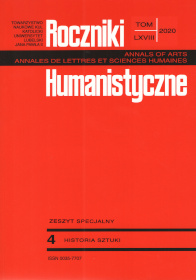Ferule of St. Pope Paul VI – an Innovation and a Symbol of Tradition
Abstract
Among the topics of the Second Vatican Council were issues related to art. Pope Paul VI wanted contemporary art to open up to a new post-Conciliar era in the history of the Church. Artistic events and the works of modern art themselves, under the patronage of the Pope, in conservative environments, provoked discussions on contemporary religious art, and even the lack of consent for artists to depart from accepted canons of art. Perhaps the greatest opposition of conservatives was caused by the papal ferula, a centuries-old sign of the pope’s religious authority given by God. Paul VI ordered a new ferule from the sculptor Lello Scorzelli. Paul’s VI ferule is an example of a work of modern art, but the symbolism contained in it refers to the old tradition. The arrangement of the tormented, elongated body of Christ refers to medieval doloristic crucifixions – painful crosses. Christ on the ferule was crucified on the Tree of Life, which symbolically gives food to life for Christians. The form of a bent, not straight cross beam was also taken from the period of medieval art. It was a symbolic break with the statement that the pope’s authority came from God. At the same time, he symbolically stated the pope’s obedience to the mystery of the cross and his apostolic mission. Ferule St. Pope Paul VI in his apostolic mission used Popes: John Paul I, and the longest St. John Paul II.
References
Aubert, Roger, „Półwiecze, które przygotowało Sobór Watykański II”. Historia Kościoła, t. 5, 1848 do czasów współczesnych, tłum. Tadeusz Szafrański, red. Luis J. Rogier, Roger Aubert, i M. Dawid Knowles, PAX, 1985, ss. 397-472.
Francovich, Gezy de. „L‘orgine e la diffusione del crocifi sso gotico doloroso“. Kunstgeschichtliches Jahrbuch der Bibliotheca Herziana, nr 2, 1938, ss. 143-263.
Kalina, Pavel. «Giovanni Pisano, the Dominicans, and the Origin of the ‹crucifi xi dolorosa›.» «Atribus et Historiae» Istituto per le Ricerce di Storia dell’Arte, nr 47, 2003, ss. 81-101.
Melloni, Alberto. «E scomparve la ferula conciliare. Un simbolo voluto da Paolo VI e detestato dai tradizionalisti», www.corriere.it/cultura/12_febbraio_08/melloni-scomparve-ferula-conciliare_8ae7c87a-5260-11e1-9430-803241dfdaad.shtml. Dostęp 6.02.2020.
Paolucci, Antonio. „Paweł VI i artyści”, www.osservatoreromano.va/pl/news/pawel-vi-i-artysci, Dostęp14.02.2020.
Pasierb, Janusz. „Problematyka sztuki w postanowieniach soboru”. Znak, 12, 1964, ss. 1460-1482.
„Paweł VI do artystów”. Znak, t. 16, nr 12, 1964, ss. 1425-1426.
Stefański, Jerzy, „Ferula”. Encyklopedia katolicka, red. Ludomir Bieńkowski i in., t. 5, Towarzystwo Naukowe KUL, 1989, kol. 146.
Św. Bonawentura. Pisma ascetyczno-mistyczne. Akademia Teologii Katolickiej, 1984.
Copyright (c) 2020 Roczniki Humanistyczne

This work is licensed under a Creative Commons Attribution-NonCommercial-NoDerivatives 4.0 International License.





